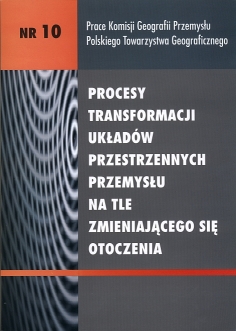Development of the Brazilian Automobile Industry in the years 1957–2005
DOI:
https://doi.org/10.24917/20801653.10.13Keywords:
przemysł, samochodowy, BrazyliaAbstract
The article examines development of the Brazilian automobile sector from the path-breaking program of installation an automotive industry in 1956 until the year 2005. The efforts of the Brazilian government to produce motor vehicles were part of a general import-substituting development strategy. The main aim of this plan was to restrict import of cars and completely or semi-knocked-down kits (CKDs or SKDs), which were assembled locally, and forced international automotive companies to choose between abandoning the Brazilian market and, with the help of financial incentives, producing cars with 90-95% Brazilian-made content within five years.The plan implemented by Brazil’s government was successful in accelerating the development of automobile sector. After the recession period in the early and mid-1960s, partially induced by the military coup d’état in 1964, at the end of the 1960s the automobile sector showed signs of having achieved maturity. During the 1970s production of this industry was growing very fast, exceeding the level of 1 million cars in the year 1980. The raise in the prices of petroleum at the end of the 1970s triggered off an economic crisis in Brazil, lasting until the beginning of the 1990.The process of economic stabilization undertaken since the implementation of the Fernando Cardoso’s “Plano Real” in 1994 led to relative economic stability, which, despite the period of economic crises in late 1998 and early 1999- lasted until the year 2005. Economic stabilization drove car manufacturers to the second large expansion at the Brazilian automobile sector. The combined value of investments in the years 1994-2001 exceeded 14.8 millions USD. It was connected with the second large wave of migration of international car manufactures to Brazil (Tab. 1).As a result of such large investments the car production exceeded the level of 2.5 millions vehicles, of which more than 2 millions constituted passenger cars. New FDI in this sector produced also a strong territorial competition among Brazilian states, which triggered short-term spells of economic growth in the place of new investment but was unlikely to lead to any long-term economic benefits (Rodriguez-Poze, Arbix 2001). One of clearly visible effects of new investments is geographical dispersion of automobile industry, and the end of domination in car manufacturing of the state of São Paulo (Fig. 4). The second great improvement took place in productivity of the Brazilian car factories. The productivity per worker increased, in the years 1990-2005, from 7.8 to 26.8 vehicles per employee per annum, which was connected with production modernization in existing plants, and implementation of new technology in “greenfield” plants, and resulted in employment reduction (Fig. 5).Downloads
Metrics
References
Anuário da Indústria Automobilística Brasileira edição 2006, 2006, Associação Nacional dos Fabricantes de Veiculos Automotores – ANFAVEA, São Paulo. (http://www.anfavea.com.br/anuario.html)
Industria Automobilistica Brasileira – 50 anos, 2006, Associação Nacional dos Fabricantes de Veiculos Automotores – ANFAVEA, São Paulo. (http://www.anfavea.com.br/50anos.html)
Laplane M.F., Sarti F., 1997, The Restructuring of the Brazilian Automobile Industry in the Nineties,Actes du GERPISA, vol. 20, s. 31–49.
Liberska B., 1989, Brazylia przyszłości. Strategia rozwoju Brazylii jako przyszłej potęgi światowej w okresie rządów wojskowych 1964–1985, Warszawa.
Rachid A., Donadone J.C., Bento P.E.G., 2002, New investments and industrial location: labour qualification and organizational strategies, Tenth GERPISA International Colloquium, 6–8 June, Paris. (http://www.gerpisa.univ-evry.fr/rencontre/10.rencontre/Papers.html)
Rodriguez-Poze A., Tomaney J., 1999, Industrial Crisis in the Centre of the Periphery: Stabilisation, Economic Restructuring and Policy Responses in the São Paulo Metropolitan Region, „Urban Studies”, vol. 36/3, s. 479–498.
Rodriguez-Poze A., Tomaney J., Klink J., 2001, Local empowerment through economic restructuring in Brazil: the case of the greater ABC region, „Geoforum”, vol. 32, s. 459–469.
Rodriguez-Poze A., Arbix G., 2001, Strategies of waste: bidding wars in the Brazilian automobile sector, „International Journal of Urban and Regional Research”, vol. 25/1, s. 134–154.
Shapiro H., 1989, State Intervention and Industrialization: The Origins of the Brazilian Automotive Industry, „Business and Economic History”, Second Series, vol. 18, s. 26–30.
Shapiro H., 1991, Determinants of Firm Entry into the Brazilian Automobile Manufacturing Industry, 1956–1968, „Business History Review”, vol. 65, no. 4, s. 876–947.
Downloads
Published
How to Cite
Issue
Section
License
Articles are published under the terms of the Creative Commons License (CC BY-ND 4.0; Attribution– NoDerivs).

